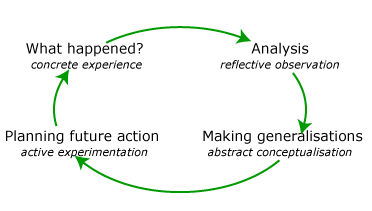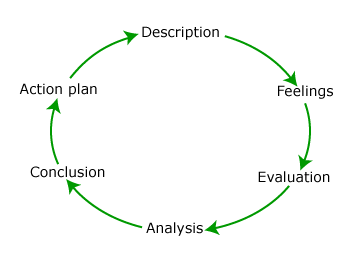Reflection
This article or section is currently under construction
In principle, someone is working on it and there should be a better version in a not so distant future.
If you want to modify this page, please discuss it with the person working on it (see the "history")
Definition
Reflection is a metacognitive strategy to help learners as individuals or organizations reflect upon experiences, actions and decisions taken. A practitioner engages in reflection when problem in practice arises and an attempt is made to understand and resolve it. Reflection as a pedagogy can be seen as an application of Dewey's experiential learning theories and extension to problem-based learning based on constructivist values. Reflection involves an active exploration of experiences to gain new or greater understanding.
Models of reflection
Many models of reflection have been proposed to be used as metacognitive tools.
Schön's model of reflection
Donald Schön looked at differentiating the tacit knowledge inherent in expert practitioners from explicit technical or theoretical knowledge, defining the notions of reflection-in-action (the use of a repertoire of theories, examples and actions to new situations, i.e. the capacity to think what one is doing while doing it) reflection-on-action (looking at the event or problem and how it was dealt with afterwards) (Schön, 1983).
The practice of using reflection as a learning strategy appears to focus on turning the latter into the former, so that learners may better capitalize on the learning opportunities offered in a particular experience and internalize the knowledge gained through their experience in order to build up a repertoire to draw upon in the future.
Other models
- Greenaway 3-stage model
Based on a simple 3-stage experiential learning cycle the Greenaway model suggests a Plan>>Do>>Review>> cycle

- Gibbs’ reflective cycle (1988)
- Johns’ model for structured reflection (1994)
useful as an analysis of a incident or general experience. Johns recognizes the benefits of sharing reflections which is an essential part of building a community of practice.
Johns also uses Carper’s (1978) four patterns of knowing, aesthetics, personal, ethics and empirics adding a fifth pattern ‘reflexivity’.
- Kolb’s Learning Cycle (1984)
A model based directly on Kolb's experiential learning cycle where active experimentation leads to a transfer of learning from current cycle to a new cycle.

Rolfe et al (2001) Framework for reflexive practice
What? So what? Now what?
- Atkins and Murphy’s model of reflection (1994)
Use of reflection in education
- professional development
- with adolescents
Promoting reflection-on-action
- Journals as reflective writing
- Video and Audio taping
- Critical incident technique - "identification of behaviours deemed to have been either particularly helpful, or particularly unhelpful, in a given situation"
- Discussion
- Drawing/Concept mapping
- Role playing
- Storytelling
Promoting reflection-in-action
According to kalli, here the methods become a little more esoteric, but the aim of these activities are to provide physical relaxation and mental grounding that will enhance reflection in a particular situation.
- Mindfulness
- Meditation/Yoga/Physical activity
- Music
reflective writing guidelines
Related resources
References
- Using a model of reflection
- [1]
- Reflection
- Greenaway, R. (1988). Powerful Learning Experiences in Management Learning and Development [2]
- Schön D (1983) The reflective practitioner. Basic Books: New York
- Sherwood, G. et al. (2005). The Scholarship of Reflective Practice, a resource paper from the Scholarship of Reflective Practice Task Force at University of North Carolina at Chapel Hill School of Nursing. [3]
